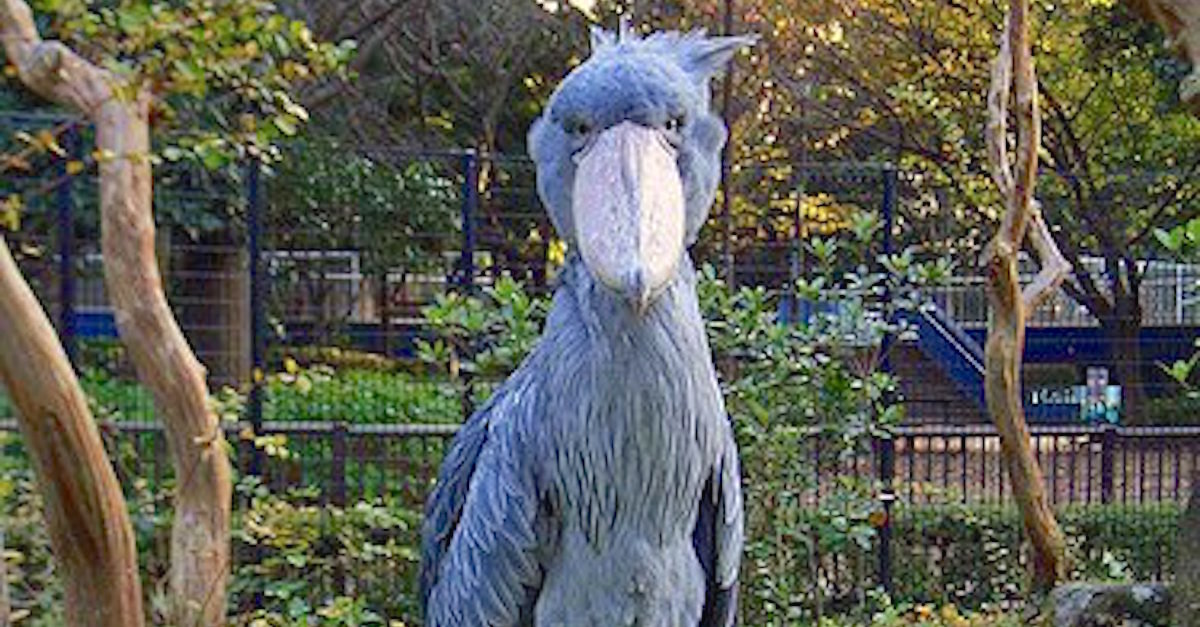

The eyes are large and yellowish or grayish-white in color. The mandibles have sharp edges that aid in capturing and eating prey. The color of the bill is yellowish with blotchy dark spots. It is an enormous structure ending in a sharp, curved hook. The bill is the most prominent feature of shoebill storks and resembles a wooden shoe. A newly hatched shoebill stork is covered in silvery-grey silky down and juveniles are a slightly darker shade of grey than adults. On the back of the head is a small tuft of feathers that can erect in a crest. Adult breeding plumage does not differ from non-breeding plumage. The underparts are a lighter shade of grey. The primaries are black-tipped and secondaries have a greenish tint. The plumage is slaty blue-grey overall with a darker grey head. Males are larger than females and have longer bills. Large, somewhat frightful looking birds, shoebill storks stand 110 to 140 cm tall. This causes the fish living in the water to surface for air more often, increasing the likelihood a shoebill stork will successfully capture it. They are also found where there is poorly oxygenated water. When shoebill storks are in an area with deep water, a bed of floating vegetation is a requirement. They are often found in areas of flood plain interspersed with undisturbed papyrus and reedbeds. Shoebill storks inhabit freshwater swamps and extensive, dense marshes. This bird's range usually coincides with that of papyrus and lungfish. Smaller populations occupy eastern Zaire and Rwanda. The main populations are found in southern Sudan (mainly in the White Nile Sudd), the wetlands of northern Uganda and western Tanzania and the Bangweulu swamp of northeastern Zambia. The activity of hippopotamus may inadvertently benefit the shoebill, as submerged hippos occasionally force fish to the surface.Shoebill or whale-headed storks are endemic to Africa and inhabit the east-central part of the continent. Frequently water and vegetation is snatched up during the strike and is spilled out from the edges of the mandibles. However, depending on the size of the prey, handling time after the strike can exceed 10 minutes. When prey is spotted, it launches a quick violent strike. Unlike some other large waders, this species hunts entirely using vision and is not known to engage in tactile hunting. While hunting, the shoebill strides very slowly and is frequently motionless. This species stalks its prey patiently, in a slow and lurking fashion. Shoebills, being solitary, forage at 20 m (66 ft) or more from one another even where relatively densely populated. Exceptionally for a bird this large, the shoebill often stands and perches on floating vegetation, making them appear somewhat like a giant jacana, although the similarly sized and occasionally sympatric Goliath heron (Ardea goliath) is also known to stand on aquatic vegetation. The shoebill is attracted to poorly oxygenated waters such as swamps, marshes and bogs where fish frequently surface to breathe. However, while foraging, if dense vegetation stands between it and humans, this wader can be fairly tame. They are quite sensitive to human disturbance and may abandon their nests if flushed by humans. The shoebill is noted for its slow movements and tendency to stay still for long periods, resulting in descriptions of the species as “statue-like”. Additionally, both humans and the shoebill stork eat omnivorous diets and face similar predators. The shoebill stork can grow taller than some humans, depending on age and gender. The wings are broad, with a wing chord length of 58.8 to 78 cm (23.1 to 30.7 in), and well-adapted to soaring. The neck is relatively shorter and thicker than other long-legged wading birds such as herons and cranes. The shoebill’s feet are exceptionally large, with the middle toe reaching 16.8 to 18.5 cm (6.6 to 7.3 in) in length, likely assisting the species in its ability to stand on aquatic vegetation while hunting.

The dark coloured legs are fairly long, with a tarsus length of 21.7 to 25.5 cm (8.5 to 10.0 in). The signature feature of the species is its huge, bulbous bill, which is straw-coloured with erratic greyish markings.Īs in the pelicans, the upper mandible is strongly keeled, ending in a sharp nail. Weight has reportedly ranged from 4 to 7 kg (8.8 to 15.4 lb).Ī male will weigh on average around 5.6 kg (12 lb) and is larger than a typical female of 4.9 kg (11 lb).

Length from tail to beak can range from 100 to 140 cm (39 to 55 in) and wingspan is 230 to 260 cm (7 ft 7 in to 8 ft 6 in). The shoebill is a tall bird, with a typical height range of 110 to 140 cm (43 to 55 in) and some specimens reaching as much as 152 cm (60 in).


 0 kommentar(er)
0 kommentar(er)
